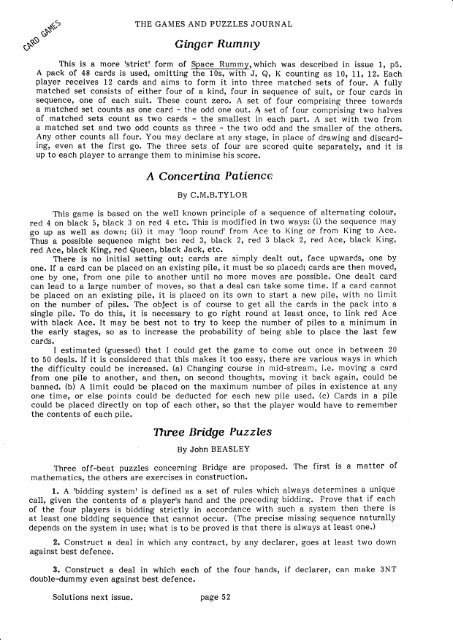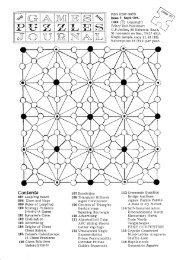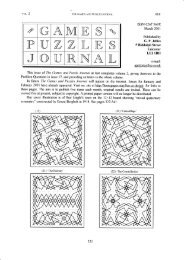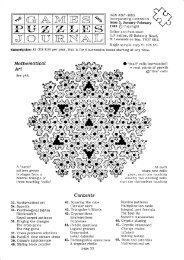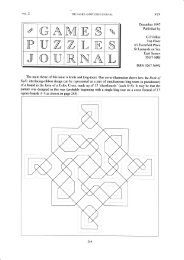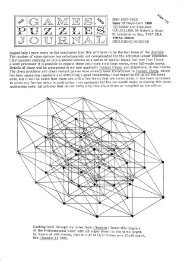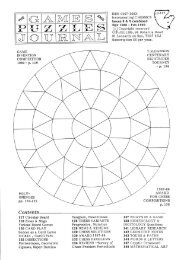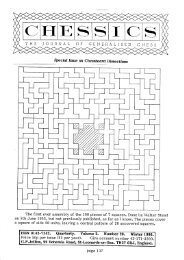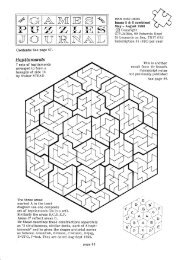The Games and Puzzles Journal, #4 - Mayhematics
The Games and Puzzles Journal, #4 - Mayhematics
The Games and Puzzles Journal, #4 - Mayhematics
You also want an ePaper? Increase the reach of your titles
YUMPU automatically turns print PDFs into web optimized ePapers that Google loves.
.-s<br />
"s<br />
THE GAMES AND PUZZLES..IOURNAL<br />
Grnger Rurnnty<br />
This is a moretstricil form of Space Rummyrwhich was descnibed in issue 1, p5.<br />
A pack of 48 cards is used, omitting the 10s, with J, Q, K counting as 10, 11, 12. Each<br />
player receives 12 cards <strong>and</strong> aims to form it into three matched sets of four. A fully<br />
matched set consists of either four of a kind, four in sequence of suit, or four cards in<br />
sequence, one of each suit. <strong>The</strong>se count zero. A set of four comprising three towards<br />
a rnatphed set counts as one card - the odd one out. { set of four comprising two halves<br />
of . matched sets count as two cards - the smallest in each part. A set with two from<br />
a matched set <strong>and</strong> two odd counts as three - the two odd <strong>and</strong> the smaller of the others.<br />
Any other counts all four. You may declare at any stage, in place of drawing <strong>and</strong> discarding,<br />
even at the first go. <strong>The</strong> three sets of four are scored quite separately, <strong>and</strong> it is<br />
up to each player to arrange them to minimise his score.<br />
A Concertino Poti,encg<br />
By C.M.B.TYLOR<br />
This game is based on the well known principle of a sequence of alternating colour,<br />
red 4 on bllck 5, btack 3 on red 4 etc. This is modified in two ways: (i) the sequence may<br />
go up as well as down; (ii) it may tloop round' from Ace to King or from King to Ace.<br />
thus a possible sequence might be: red 3, black 2, red 3 black 2, red Ace, black King'<br />
red Ace, black King, red Queen' black Jackr etc.<br />
<strong>The</strong>re is no initial setting out; cards are simply dealt out, faee upwards' one by<br />
one. If a card can be placed on an existing pile, it must be so placed; cards are then moved'<br />
one by one, from one pile to another until no more moves are possible. One dealt card<br />
can lead to a large number of moves, so that a deal can take some time. If a card cannot<br />
be placed on an existing pile, it is placed on its own to start a new pile, with no limit<br />
on the number of piles. <strong>The</strong> obJect is of course to get all the cards in the pack into a<br />
single pile. To do this, it is necessary to go right round at least once, to link red Ace<br />
with black Ace. It may be best not to try to keep the number of piles to a minimum in<br />
the early stages, so as to increase the probability of being able to place the last few<br />
cards.<br />
I estimated (guessed) tnat I could get the game to come out once in between 20<br />
to 50 deals. If it is considered that this makes it too easy, there are various ways in which<br />
the difficulty could be increased. (a) Changing course in mid-stream, i.e. moving a card<br />
from one pile to another, <strong>and</strong> then, on second thoughts, moving it back again, could be<br />
banned. (b) A limit could be placed on the maximum number of piles in existence at any<br />
one time, or else points could be deducted for each new pile used. (c) Cards in a pile<br />
could be placed directly on top of each other, so that the player would have to remember<br />
the contents of each pile.<br />
Thl,e Brtdge <strong>Puzzles</strong><br />
By John BEASLEY<br />
Three off-beat puzzles concerning Bridge are proposed. <strong>The</strong> first is a matter of<br />
mathematics, the others are exercises in construction.<br />
L. A 'bidding systemr is defined as a set of rules which always determines a unique<br />
call, given the contents of a playerrs h<strong>and</strong> <strong>and</strong> the preceding biddine. Prove that if each<br />
of the four players is bidding strictly in accordance with such a system then there is<br />
at least one bidding sequence that cannot occur. (<strong>The</strong> precise missing sequence naturally<br />
depends on the system in use; what is to be proved is that there is always at least one.)<br />
2. Construct a deal in which any contract, by any declarer, goes at least two down<br />
against best defence.<br />
3. Construct a deal in which each of the four h<strong>and</strong>s, if declarer, can make 3NT<br />
double-dum my even against best defence.<br />
Solutions next<br />
issue. page 52


